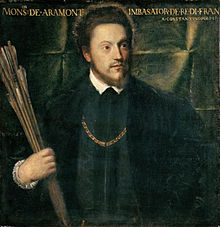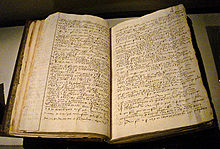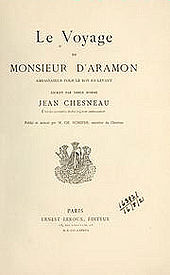- Gabriel de Luetz
-
 Portrait of ambassador to the Ottoman Porte Gabriel de Luetz d'Aramont, by Titian, 1541-1542, oil on canvas, 76 x 74 cm.
Portrait of ambassador to the Ottoman Porte Gabriel de Luetz d'Aramont, by Titian, 1541-1542, oil on canvas, 76 x 74 cm.
 Encoded letter of Gabriel de Luetz d'Aramon, after 1546, with partial deciphering, an interesting example of cryptography in the 16th century.
Encoded letter of Gabriel de Luetz d'Aramon, after 1546, with partial deciphering, an interesting example of cryptography in the 16th century.
Gabriel de Luetz, Baron et Seigneur d'Aramon et de Vallabregues (died 1553), often also abbreviated to Gabriel d'Aramon, was the French Ambassador to the Ottoman Empire from 1546 to 1553, in the service first of Francis I, who dispatched him to the Ottoman Empire, and then of the French king Henry II. Gabriel de Luetz was accompanied by a vast suite of scientists, Jean de Monluc, philosopher Guillaume Postel, botanist Pierre Belon, naturalist Pierre Gilles d'Albi, the future cosmographer André Thévet, traveler Nicolas de Nicolay who would publish their findings upon their return to France and contribute greatly to the development of early science in France.[1]
In 1547, he accompanied Suleiman the Magnificent on his conquest of Persia in the Ottoman-Safavid War (1532–1555), with two of his secretaries, Jacques Gassut and Jean Chesneau, and is recorded as having given advice to the Sultan on some aspects of the campaign.[2] Chesneau wrote Le Voyage de Monsieur d'Aramon dans le Levant,[3] an interesting account of the travels of Gabriel de Luetz.[4]
In 1551, Gabriel de Luetz joined the Ottoman fleet to attend to the Siege of Tripoli, with two galleys and a galliot.[5][6]
Gabriel de Luetz is also known to have convinced Suleiman to send a fleet against Charles V,[7] for a combined Franco-Turkish action in 1552.[8] In July 1552, the fleet raided Rhegium in Calabria, laying waste to 30 miles of coast, with Gabriel de Luetz onboard who reported the devastation in a July 22 dispatch to the king of France:[9]
"[The Turks] burnt all the castles and villages on their descent, for twelve or fifteen miles along the shore, and, without making any stop, the said Captain of the fleet, following the coast, intended to spread the flames from one end of the coast to the other."Gabriel de Luetz was succeeded by Michel de Codignac as ambassador to the Porte, who himself was succeeded by Jean Cavenac de la Vigne.[10]
Diplomatic posts Preceded by
Antoine Escalin des AimarsFrench Ambassador to the Ottoman Empire
1547–1553Succeeded by
Michel de CodignacSee also
- Franco-Ottoman alliance
Notes
- ^ McCabe Orientalism in early modern France, p.48
- ^ The Cambridge History of Iran, p.382
- ^ Braudel, p.920
- ^ New general biographical dictionary Henry John Rose, Thomas Wright Fellowes, 1848 [1]
- ^ The Mediterranean and the Mediterranean world in the age of Philip II by Fernand Braudel p.920- [2]
- ^ The Papacy and the Levant (1204-1571) by Kenneth M. Setton p.555-
- ^ The Biographical Dictionary of the Society for the Diffusion of Useful Knowledge [3]
- ^ Tracy, p.233
- ^ a b The History of England Sharon Turner, p.311
- ^ Setton, p.692
References
- The Cambridge History of Iran University of Cambridge, William Bayne Fisher, Peter Jackson, Harold Bailey, Peter Jackson, historian, Ilya Gershevitch, Laurence Lockhart, Richard Nelson Frye, Iḥsān Yāršātir, A J Arberry, J A Boyle, Ehsan Yar Shater Cambridge University Press, 1986 ISBN 0521200946
- Kenneth M. Setton The Papacy and the Levant (1204-1571) DIANE Publishing, 1984 ISBN 0871691620
- Frenand Bruadel The Mediterranean and the Mediterranean world in the age of Philip II Volume II University of California Press, 1996 ISBN 0520203305
Categories:- Ambassadors of France to the Ottoman Empire
- 1553 deaths
Wikimedia Foundation. 2010.


